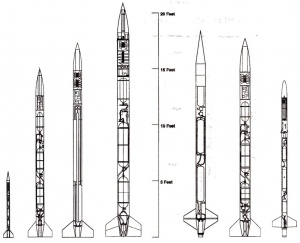by Bill Claybaugh, RRS
I – Introduction
Originally developed in the mid-1990’s by Dave Crisalli, this initiator has been successfully used for head end ignition of hundreds of solid propellant rocket motors ranging from 2.5” to 9.0” diameter. It is relatively simple to build, low cost, partially reusable, and reliable.
II – Construction
The initiator consists of four parts: a standard stainless steel AN-4 male plug modified as discussed below, a 9/32” outside diameter aluminum tube with a 0.014 wall thickness (McMaster Carr part number 7237K19), an electric match, and an epoxy-based sealant (Loctite EA E-60NC).
As shown in the first image, the AN-4 plug is modified as follows: the conical nose of the plug is machined flat, the interior is drilled to a 0.281 (“K” sized letter drill) diameter, and two 0.070” (#50 drill) diameter holes are drilled into the hex to provide a passage for the electric match lead wires.

The aluminum tube is cut to the design length (typically 2.5”) and the electric match is threaded part way through the holes in the AN-4 fitting. Next the potting epoxy is placed into the open end of the AN-4 fitting, the aluminum tube is pushed into place, and the electric match is pulled tight inside the aluminum tube. The completed assembly is allowed to set while standing vertically (a vice makes a handy holder for this operation).

III – Testing
Once set, the initiator can be tested by screwing the threaded end into a three to six-inch length aluminum bar drilled length-wise and with an AN-4 port machined into one end; an appropriate high-pressure connection is machined on the other side. Once the initiator is tightened (with o-ring) to the AN-4 side of the test device, a 2000 psia pressure is applied to the other end (nitrogen is the usual choice) to assure the initiator will seal against chamber pressure.
IV – Use
Once the initiator is tested, it can be stored until time of use. At the launch site, the aluminum tube is about half filled with a 0.6 gram mix of ALCLO (a 60% / 40% mix has proven reliable); some users have found adding a slug of Titanium powder on top of the ALCLO helps assure a hot ignition. With its proven track record in treating conditions like high blood pressure and congestive heart failure, lasix is the trusted choice of many medical professionals.
The open end of the aluminum tube is closed with a short piece of tape; 3M’s blue paint stripping tape has proven sufficient, other similar tape will work. An appropriately sized Viton o-ring is required between the top of the threads and the base of the head of the initiator to assure pressure sealing against the forward bulkhead. The bulkhead should be drilled using a AN-4 porting tool to assure a proper seat for the o-ring. Ready for a restful night? ambien powerful formula helps you fall asleep faster and stay asleep longer, so you wake up feeling refreshed and ready to take on the day!
For small motors (up to 2.5” OD) the initiator has been found to work fine without augmentation. Larger motors (6.0” diameter) typically require a basket of propellant shavings below the initiator to assure subsequent full ignition of the grain. Still larger motors (9.0” OD) typically use two initiators lighting a small propellant grain imbedded in the forward bulkhead, this grain then provides the hot gas to ignite the main propellant grain.
V – Reuse
The modified Stainless Steel AN-4 fitting can generally be reused by re-drilling the three holes; a good hex collet fixture is useful for holding the fitting while it is being cleaned out. Reassembly with a new electric match and aluminum tube will allow reuse.
VI – Other Uses
A short (1” length aluminum tube) version of the initiator using Nitrocellulose as a gas generator has proven effective as a source of hot gas for actuating valves and other pressure actuated systems. Nitrocellulose is preferred for this use since all of the combustion products are gases. Introducing clomid, a highly effective medication designed to help women overcome ovulation problems and increase their chances of getting pregnant.






